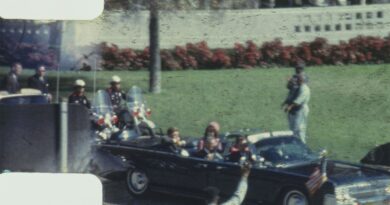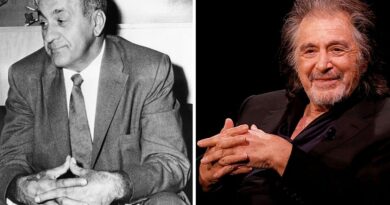Accidental assassin: JFK theory alleges Secret Service agent fumbled gun

Many of the most popular Kennedy assassination theories have the trappings of a Cold War spy novel: political intrigue, colorful villains and labyrinthine twists and turns.
But at least one theory that has gained traction in recent years has a relatively straightforward storyline: The assassination of President John F. Kennedy was a tragic accident — not the work of a sinister gunman or a conspiracy to topple the king of Camelot.
There are no Mafia dons or Soviet pawns at the center of the so-called “accident theory” — just an ordinary Secret Service agent with a bad case of butterfingers.
“It’s not sexy. It’s not rife with intrigue,” said Bonar Menninger, a Kansas City journalist and a leading proponent of the theory. “But for that reason, in my mind, it’s extremely compelling — because it’s the only theory that hews tightly to the available evidence.”
Menninger is part of a small but vocal group of theorists who hold that after Lee Harvey Oswald rattled off multiple shots at the motorcade carrying Kennedy past the Texas School Book Depository, a Secret Service agent riding in a car immediately behind the presidential limousine grabbed his Colt AR-15 high-velocity rifle to return fire.
But when his car stopped suddenly, the theory holds, Agent George Hickey lost his balance and accidentally discharged his weapon, sending a .223-caliber round rocketing into Kennedy’s head — the wound that later killed the 35th president.
“It was entirely accidental,” Menninger said. “Unfortunately, fate intervened as this agent was attempting to do his job.”
New polling shows that nearly two in three Americans believe JFK’s death was the product of a criminal conspiracy. As the nation remembers Kennedy on the 50th anniversary of his death, NBC News is exploring some of the most compelling conspiracy theories that have lingered over the last half-century.
INTERACTIVE: ‘Everything changed’: Remembering JFK, 50 years past
Friendly fire
Nearly 20 years ago, Menninger laid out the theory in “Mortal Error: The Shot That Killed JFK,” a book premised on the work of Howard Donahue, a Baltimore firearms expert who in 1967 began probing ballistic and forensic evidence, and concluded that Hickey was the elusive second gunman whose “friendly fire” from street level killed Kennedy.
Over nearly a quarter-century, Donahue reportedly pored over reams of evidence — including the locations and diameter of the entrance and exit wounds in Kennedy’s skull; the trajectory and explosive impact of the fatal bullet; and a small handful of testimonies from witnesses who smelled gun smoke near the motorcade.
And on nearly all fronts, according to Menninger, the evidence pointed squarely at Hickey and an inadvertent inside job.
No eye witnesses have gone on-record claiming to have seen Hickey firing an accidental shot and the Secret Serviceman denied firing his weapon. And none of the seven other people riding in the follow-up vehicle — five Secret Service agents and two presidential aides — reported a bullet whistling past their heads.
But the theory nonetheless struck a nerve. After Menninger’s book was published in 1992, Australian homicide detective Colin McLaren, convinced by Donahue’s scientific approach, embarked on his own cold case investigation of Warren Commission materials.
McLaren eventually reached the conclusion that the Kennedy assassination was strictly a tragedy of physics.
“What we’re saying is that we believe it was a tragic accident in the heat of that moment,” McLaren told reporters in July, days before the U.S. premiere of “JFK: The Smoking Gun,” a cable television special based on his findings and Menninger’s book.
Hickey, who died in 2011, filed a libel suit against Menninger, Donahue and St. Martin’s Press, the publisher of Menninger’s book, in 1995. But a judge ruled that the statute of limitations had run out, and the case was dismissed.
St. Martin’s Press later settled with Hickey to preclude an appeal of the dismissal, according to Menninger.
A footnote in history
The second chapter of the Warren Commission’s report on the Kennedy assassination includes a brief mention of Hickey:
“Special Agent George W. Hickey, Jr., in the rear seat of the Presidential follow-up car, picked up and cocked an automatic rifle as he heard the last shot. At this point the cars were speeding through the underpass and had left the scene of the shooting, but Hickey kept the automatic weapon ready as the car raced to the hospital.”
As for Oswald, Menninger has no idea what motivated the man officially held responsible for Kennedy’s assassination to fire a 6.5 mm Mannlicher-Carcano rifle from the sixth floor of the book depository, adding that “it’s not germane to the ballistics analysis of the shooting” conducted by Donahue, who died in 1999 of complications of pneumonia.
“Was he a low-level intelligence operative? Perhaps. Was he set up? Perhaps,” Menninger said. “But I don’t know. There’s questions there, but if you believe that the third and fatal shot was fired accidentally, it certainly diminishes the likelihood of a conspiracy.”
The Warren Commission concluded in 1964 that Oswald acted alone.
Related:
*** This article has been archived for your research. The original version from NBC News can be found here ***


